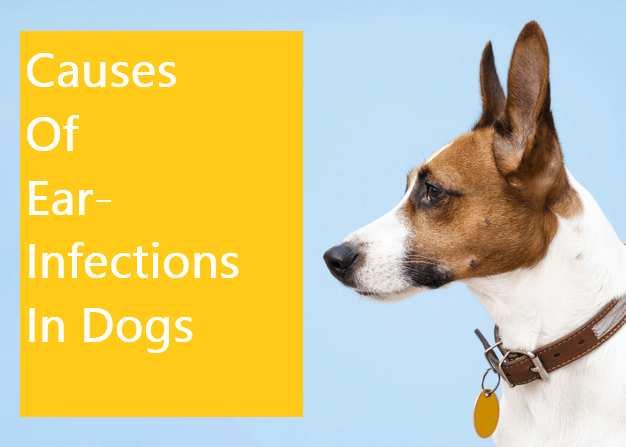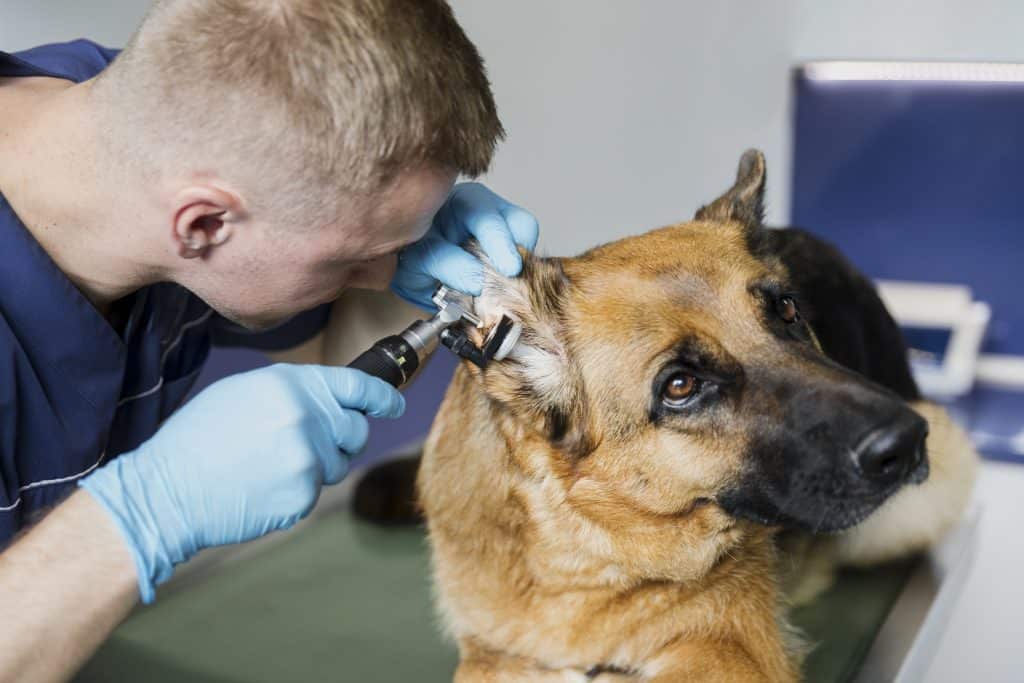Ear infections in dogs are a fairly common occurrence and are often seen in dogs with big, hairy, and floppy ears such as Miniature Poodles and Basset Hounds. However, ear infections can affect dogs of any breed.
If you are seeing signs of a dog shaking his head, scratching his ear, or whining, then it is most likely to an indication of ear infection in your dog.
Approximately 20 percent of dogs acquire and sustain some form of ear illness that may persist in either one ear or both the ears.
Table of Contents
Types of Ear Infections in Dogs

There are 3 categories of ear infections in dogs:
- Otitis Externa – It is the infection of the cells in the external part of the ear canal. It is the most common type of infection.
- Otitis Media – It is the infection of cells in the middle part of the ear canal. The infection that affected the external portion of the ear spreads gradually to the middle portion of the ear resulting in Otitis Media. It can lead to facial paralysis, deafness, and vestibular disease.
- Otitis Interna – It is the infection of cells in the inner part of the ear canal. The infection that affected the external portion of the ear spreads gradually to the middle portion and then to the internal portion of the ear resulting in Otitis Interna.
The inner ear infections in dogs can lead to facial paralysis, deafness, and vestibular disease.
It is crucial to seek advice from the vet and discuss the remedies for ear infections in dogs before the infections spread further in your dog and become too serious to repair.
Symptoms of Dog Ear Infections

The pain that accompanies an ear infection can be difficult for your dog to tolerate.
If you see an ear canal discharge or a wax buildup in your dog’s ears, it can be a sign of an ear infection.
During ear infections, you will observe the dog experiencing uneasiness and he may display signs of the following:
- Shaking of the head and scratching of the ear to alleviate the discomfort
- Redness and inflammation in the ear accompanied by a foul odor
- A discharge having a black or yellowish color
- In severe cases, crusting or scabs in the ear and narrowed ear canals due to inflammation
Causes of Ear Infections in Dogs

Ear mites in dogs are tiny creatures that reside in the ears of dogs. They may be the culprit of many of the dog ear infection symptoms.
However, the ear mites cause infections most commonly in puppies. The grown-up adult dogs are likely to contract the mites from puppies.
Ear mites more often than not give rise to dog ear yeast infections and bacterial infections.
Microorganisms such as several bacteria and some fungi are well-known causes of ear infections in dogs. If your dog’s ears smell and have a dark brown discharge, it likely indicates yeast overgrowth. There may be itching accompanied by yeast.
Greenish or yellow discharge with a foul odor indicates a bacterial infection.
The ear canal in dogs is shaped in such a way that it tends to keep fluid within itself and thus likely to result in an ear infection.
Factors that can make your dog susceptible to ear infections include:
- The Anatomy – A dog having long, flappy ears will be at a bigger risk of ear infections. These types of ears can easily entrap dirt, dust, and moisture. Also, the air circulation becomes restricted in flappy ears. The occurrence of wax buildup and discharge is more likely here as is the growth of bacteria.
- The Lifestyle – Poor lifestyle can facilitate ear infection. Not feeding a raw diet, giving unnecessary vaccinations, exposure to chemicals and pesticides, can all lead to ear infections.
- The Diet – Ensure you give kibble carefully, as many dogs have food allergies and intolerance toward such food. Feeding fresh and raw food is always a safer option for your dog’s health. Ensure giving your dog a balanced diet and nutritious food. Allergies have been known to cause ear diseases in nearly 50 percent of dogs.
- Cleaning Ears in Excess – Don’t clean the ears if the wax is not much and the dog doesn’t show signs of uneasiness. Even unintentional excessive cleaning of the ears can result in skin irritation and inflammation.
- Autoimmune Disorders – These put stress on the dog’s immune system and make him unable to tolerate such stressors
- Moisture – It creates the most conducive environment for the birth and growth of yeast and bacteria
- Ear canal injury – The insertion of an object very deep in the ear canal causes the injury
- Disorders of the endocrine system – such as thyroid disease
- Foreign objects – Your dog can unknowingly have grass seeds, a bug, water, dust, etc. inserted into its ear canal. If shaking his head doesn’t get the dog rid of these objects, he can develop inflammation and bacterial growth.
- Aural Hematoma – In this condition, the blood vessels in the flap of the ear break down, and this results in painful swelling that calls for surgical treatment. Find more information on the condition by clicking here.
- Leaky Gut – If your dog gets frequent ear infections, then the problem could be a leaky gut. Dogs possessing chronic health issues often have them due to a leaky gut. Bacteria and toxic substances can hurt the lining in the gut. The permission of toxic material into the bloodstream causes many chronic problems such as frequently occurring ear infections. Causes of a leaky gut are pharmaceutical drugs and toxic substances, poor diet, and excessive vaccination.
- Hyperplasia/Stenosis – The ear canal gets closed in this condition. If you see the canal swollen, that means it is nearly impossible to administer medications, in which case, anti-inflammatory medications can lessen the swelling and open the canal. However, in most cases of hyperplasia, surgery will be necessary.
Diagnosis for Ear Infections in Dogs

Once you are sure that your dog is showing indications of an ear infection, immediately schedule an appointment with a vet.
Sooner treatment is not only required for the alleviation of your dog’s pain but also to stop the spread of the infection to the more sensitive parts of the ear.
Other than in exceptional cases, try to avoid treatment at home by yourself.
When you visit the vet, you will have to provide him with a thorough history of your dog’s ear problem, especially if the infection is occurring for the first time.
Your vet may check for the following information:
- How long he has had the symptoms, such as discharge, pain, odor, and swelling
- Whether your dog is allergic or not
- Whether your dog is taking medications or not
- What food your dog has been consuming
- How frequently are the dog’s ears cleaned and which products are used
- Whether the hair in the dog’s ears has been plucked or trimmed
- A list of recent activities, such as swimming, baths, or grooming
- The history of your dog’s ear infections. The time of their occurrence, and the way they were treated.
After the vet takes your dog’s history, he will undertake a physical examination. In grave cases, the vet may suggest sedating your dog for a deeper examination of the ear canal.
The examination for evaluating both the ears will include:
- Assessment by sight to check for signs of discharge, redness, and swelling
- Examination of the ear canal with an otoscope (a tool that provides light and magnification). This facilitates the vet in determining whether the eardrum is sound and whether there is any foreign object in the canal.
- Feeling the ear to determine the level of pain. If the dog is in a lot of pain and is reluctant for an examination, the vet may anesthetize or sedate the dog for a proper examination.
- Examination of a sample of substance from the ear canal with a microscope to ascertain the type of organism responsible for the infection. This procedure will assist the vet in opting for the right medicinal treatment for dog ear infection.
- A Culture sample from the ear is taken and susceptibility tests are performed to verify that the dog is receiving the right medication. Note that this procedure may be undertaken only in severe cases.
- In severe cases, X-rays or biopsies may be performed.
Suggested: Common Types of Dog Allergies And What To Do About Them?
Treating Ear Infections in Dogs

The vet will properly clean your dog’s ears with the help of a sterile cleaner. He may also give medications to be applied to the dog’s body at home.
If the vet finds a parasite, a plug, or a foreign object present in the ear canal, it will be removed with or without sedating the dog.
In grave scenarios, the vet may prescribe antibiotics and anti-inflammatory medicine for dog ear infections.
If the ear infections aren’t too hard to judge, they may be healed within 1 to 2 weeks of treatment.
The really bad infections can take months to heal or may sustain themselves for an indefinitely long time.
In untreatable cases, your vet may advise removing the entire ear canal through surgery. This surgery is termed as Total Ear Canal Ablation (TECA).
TECA surgery would ensure that the affected tissue has been removed and thus, preventing the infection from happening again.
It is very crucial that you abide by the vet’s instructions and visit the hospital for the suggested follow up appointments. Failure in the treatment can result in the recurrence of the ear infection.
Finishing the full series of medications for ear infections in dogs, even if he appears to be getting better, is very important. Failure regarding this can give rise to resistant infections and can exacerbate the situation.
How to Prevent Ear Infections in Dogs

Now obviously, prevention is better than cure. One of the most common reasons for ear infections for dogs is excessive moisture. Always ensure that you carefully dry your dog’s ears after bathing and swimming.
If your dog is a victim of chronic ear infections, recognizing and dealing with the underlying causes like allergies can help in stopping further occurrences of infections.
Regular dog ear cleaning at home can help prevent the onset of ear infections.
Below are the expert-recommended steps for cleaning the ear:
- Fill the cleaning solution in the ear canal and massage from the outside, the vertical ear canal.
- Completely wipe the canal with absorbent gauze. Using cotton or paper towels may leave behind fibers that could lead to irritation. Using cotton swabs in the ear canal may unintentionally push the debris further into the canal.
Pitfalls of Conventional Treatment

Conventional treatment for ear infections in dogs involves administering antibiotics and drugs. These are an effective means of treatment. However, they leave behind side effects.
Antibiotics can cause an imbalance of bacteria in the digestive system and remove the good bacteria from the system.
Steroid drugs are also sometimes prescribed by veterinarians for dealing with ear problems. Steroid drugs have the potential to suppress the immune system, which can cause many dangerous side effects.
How to Treat Dog Ear Infection Without Vet

Below are some of the natural ways you can use to treat your dog without the side effects or without the need to go to a vet:
- Sprinkle some water along with apple cider vinegar in the affected area. The vinegar will reduce the pain and uneasiness with its anti-inflammatory and antiseptic properties.
- For 10 days at a stretch, apply 5 to 6 drops of mullein with garlic oil. This results in reduces discomfort, swelling, and ends viruses.
- Massage an herbal antibiotic and mineral oil in an equal amount 2 to 3 times daily for many days.
- Hair prevents efficient air circulation into the ear, which results in dryness and susceptibility to infection. Remove (pluck) all the hair that grows in the ear canal.
- Give your dog vitamin C regularly. This makes sure his good health and prevents ear infections in the future. Vitamin C improves the immune system which assists in fighting ear infections.
Comment below to share your insights and experiences with dogs you know.
Stay connected with us to know more on dogs and their life.
Happy Petting to You Guys!












